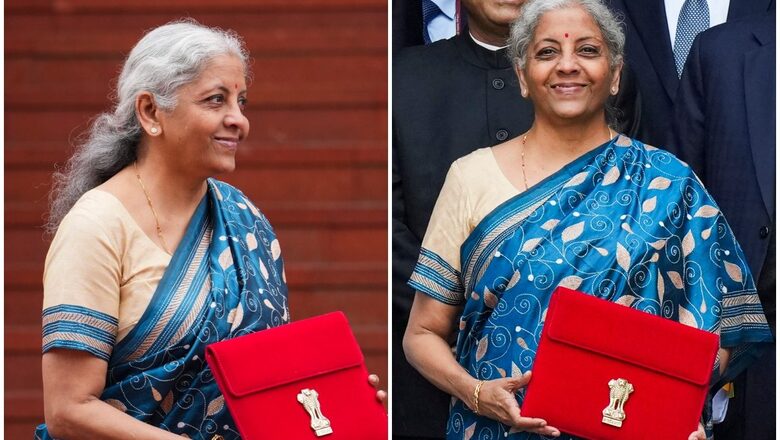
views
When Finance Minister Nirmala Sitharaman presented her sixth and 10th continuous budget (interim one, with parliamentary elections expected soon) of the Narendra Modi government, she surpassed the record of her predecessors Manmohan Singh, P Chidambaram, Yashwant Sinha and Arun Jaitley who presented five budgets each. Sitharaman achieved two more feats – one, she became the first woman finance minister to hold the full term and two, she equalled the record of the former Prime Minister Morarji Desai who, between 1959 and 1964, as finance minister had presented five annual budgets and one interim budget.
Respecting Tradition
A month prior to the budget day, Sitharaman had indicated in a public function that this being an interim budget to pass vote on accounts, there should not be much expectation, particularly of a “spectacular announcement”. Prime Minister Narendra Modi too had echoed on Wednesday, “Traditionally, when the elections are imminent, the complete budget is not presented. We will adhere to this tradition… Nirmala ji will present the budget with some guiding principles.”
The interim budget as presented today, on February 1, adheres to the tradition. It also shows the confidence of the government that after ten years of governance, it will return for another five years.
Eschewing Populism
With no major surprises and conspicuously silent on the mega promises of an election-eve budget, it completely eschews populism. The budget acknowledges 2.4 times growth in income tax return, and three times increase in the income tax receipt, along with the buoyancy in corporate tax and GST regimes but leaves both direct and indirect tax regimes unchanged. This signifies the high confidence of the government about its chances on the hustings, given its list of achievements in the last ten years and given that the Opposition is in shambles. Also, it ticks most boxes right including that of the high path of the fiscal consolidation.
A Ten-Year Recap
As best bet for the forthcoming elections, in place of announcing goodies and populist measures for the electorate, the finance minister has rightly focused on the achievements of the government in the last ten years, key outcome of which is supposed to be the comprehensive development of all, focusing on the trinity of demography, democracy and diversity, duly ensuring that entire parts of the country become active participants in the economic growth and substantive fast forward development of all forms of the infrastructure – physical, digital and social.
A few things here need special mention.
One, a key budget talk of FM Sitharaman was the focus on moving 25 crore people out of the trench of multidimensional poverty, training 1.4 crore youth under Skill India Mission, credit assistance to 78 lakh street vendors and fostering entrepreneurial aspirations of youth through 43 crore loans sanctioned under PM Mudra Yojana. This is an appreciable journey but given the fact that with the second-year continuous shrinkage of the Chinese population, India is now the most populous country in the world, as the new government takes over, all these programs must become much bigger as the country has to prepare for making approximately 9 million young men and women productive by providing them gainful employment annually.
Two, the last ten years have witnessed a massive increase in capital outlay across the economy and if the dream of Viksit Bharat by 2047 must become a reality, it needs to be turbocharged further and faster.
Three, another area that the speech focuses on is the transformation in the existential circumstances of four categories of Indians, the newest focus areas of Prime Minister Modi – the poor (or Garib), young (or the Youth), farmers (or the Annadata) and woman (Nari Sakti). This author prima facie accepts that the performance record narrated by the finance minister in her budget speech is reflective of the noteworthy achievements made by the government in the field as well as in many other areas. The achievements need to be further broad-based and fast-tracked and more importantly, need to be made sustainable. Clearly, as it emerges from the budget speech, the transformation of the nation around these four key categories will be the major plank of the next government to transform the country into Viksit Bharat.
Infrastructure Push
One area where the Narendra Modi government has accredited itself rather well in the last decade is that of a substantial increase in the capital expenditure across sectors and push for the timely and within-cost completion of infrastructure projects. The result is that across sectors, more infrastructure projects are being planned, financed, constructed and made operational in record time. The government has tripled the capital infrastructure outlay in the past four years resulting in a huge multiplier effect across the economy.
But what about FY24-25 and beyond?
Massive CapEx Requirement
An interim budget allocation is not the right barometer to gauge the true import of the government. However, the budget does talk about an 11.1 per cent increase in the CapEx budget for FY25 to Rs 11 lakh crore which is 3.4 per cent of the GDP. I posit that this planned increase is incremental and barely takes care of the outlay increase imperative due to inflation. For Bharat to be Viksit, it needs a mega infrastructure push due to the following among many reasons-
- By the end of 2023, shrinking for the second year in a row, the Chinese population was 1.40 billion and will be going down further. This makes India the most populous country in the world which will continue to grow further. More people means more and faster need of all types of physical infrastructure.
- The country is urbanising faster than expected and the urban population will be adding substantially to the GDP of the country. By 2030, the country will have a 60 crore urban population and by 2047, the urban population will be 84 crores, almost half of the country’s population This requires not only fast-tracking the growth of all types of urban infrastructure but the need to reimagine our cities and towns.
- By FY28, the country will have the largest economy in the world and in the run-up to Viksit Bharat by 2047, it will be increasingly the services capital of the world, factory to the world economy and granary to both the nation and the world.
The above provides the landscape of why and how a fast-growing nation needs to increase its infrastructure. I hope the interim budget is just a trailer and there is much more to come when the full budget is presented.
Infrastructure – The Sectoral Focus
Though the interim budget hides more and reveals less, some directional movements are discernible for a few selected infrastructure sectors. Here it is-
One, Railways – The budget does mention the implementation of the development of three major economic railway corridors identified under PM Gati Sakti for enhancing multi-modal connectivity. These corridors are (a) energy, mineral and cement corridors, (b) port connectivity corridors, and (c) high-traffic density corridors.
These projects are likely to improve logistics efficiency and reduce costs. So far, so good. But I humbly posit that the country has talked of these projects including the dedicated freight corridors for rather too long for comfort. It is action time now, time for their fast execution. The proposal to transform 40000 coaches to enhance the safety, convenience and comfort to the Vande Bharat coaches type is welcome but is fraught in implementation. The key deciding factor should be the efficacy of the planned move, the time frame of conversion and the cost of retrofitting the old coaches which should not become more than getting the new coaches themselves.
Two, Aviation – Aviation in India is a true success story with the country’s aviation market growing much faster than other countries of the world. The aviation sector has indeed been galvanised in the past ten years. The number of airports has doubled to 149 and the rollout of air connectivity to tier-two and tier-three cities under the UDAN scheme has been widespread, resulting in 517 new routes carrying 1.3 crore passengers. Indian carriers Indigo, Air India and Akasa Air have placed orders for over 1000 new aircraft. With more discretionary income and more tier 2 and tier 3 cities getting connected, Indian youth getting more mobile, the governance will be at its toe to improve and upgrade existing airports and provide for new ones. The full budget will need to provide a pathway to this sunrise sector including some way forward for the Indian airline industry to get into frequent financial and technical training.
Three, without getting into specifics that must form part of a full year’s budget, the talk of Metro Rail and Namo Bharat (RRTS) in more cities of the country is welcome but neither of the two is a panacea for the comprehensively gridlocked urban mobility of the country which needs city-centric hierarchy of sustainable solutions from metro rails to pedestrian-friendly cities.
Four, the talk of green energy too is soothing, but it requires a clear pathway and fast action if Net Zero by 2070 has to become a reality.
Five, there is one infra-area which is conspicuous for not finding a place in the infrastructure push portion of the budget – roads, highways and expressways. Even if not intentional, the pause is still timely and warranted. It is the time for deliberation and more symbiotic growth of different modes of transport in the country.
The author is Multidisciplinary Thought Leader with Action Bias and India Based International Impact Consultant. He works as President Advisory Services of Consulting Company BARSYL. Views expressed in the above piece are personal and solely those of the author. They do not necessarily reflect News18’s views.




















Comments
0 comment